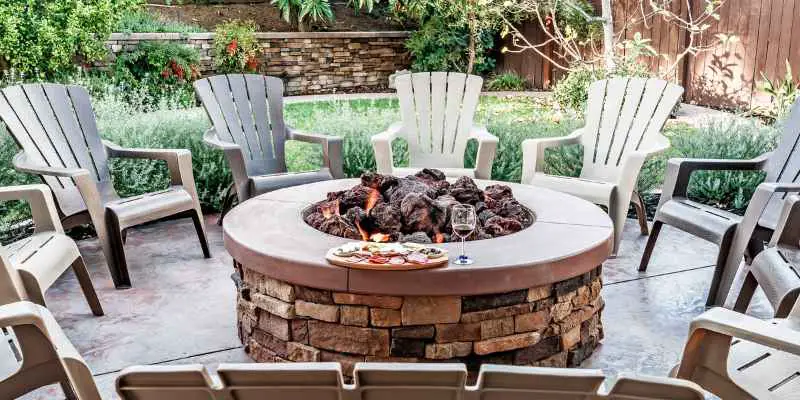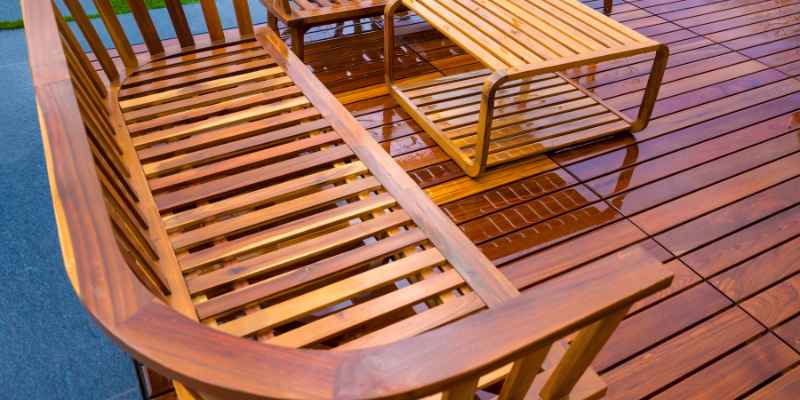Teak and cedar are the best wood options for patio furniture due to their high durability, natural resistance to decay, and beautiful aesthetics. Teak possesses natural oils that protect it from rotting, making it an excellent choice for outdoor furniture.
Cedar is also highly resistant to decay and insects, and its pleasant aroma adds to its appeal. Combining durability and visual appeal, teak and cedar are the top choices for patio furniture.
Types Of Wood For Patio Furniture
Patio furniture comes in a variety of wood types, each with its own unique characteristics. Let’s explore some popular choices:
Teak
Prized for its durability and natural resistance to decay, teak is a fantastic choice for outdoor furniture.
Cedar
Cedar wood is known for its beautiful reddish hue and natural resistance to rot and insects.
Acacia
Acacia wood is valued for its warmth and durability, making it an excellent option for patio furniture.

Factors To Consider When Selecting Wood
When selecting wood for patio furniture, consider durability, weather resistance, and aesthetics. Opt for hardwoods like teak, cedar, or eucalyptus for longevity and natural beauty. Ensure the wood is sustainably sourced to make an eco-friendly choice for your outdoor space.
Durability
When selecting wood for your patio furniture, durability is an essential factor to consider. You want your furniture to withstand the test of time and continue looking great even after years of use. Not all types of wood are created equal in terms of durability, so it’s important to choose the right wood species for your patio furniture.
Weather Resistance
Another factor to consider when selecting wood for your patio furniture is its weather resistance. Your outdoor furniture will be exposed to various weather conditions, such as rain, sun, and even snow. Therefore, it’s crucial to choose wood that can withstand these elements without easily deteriorating. Weather-resistant wood will help prolong the lifespan of your patio furniture.
Maintenance
Maintenance is a key consideration when choosing wood for your patio furniture. Some types of wood require more maintenance than others to keep them in good condition. If you prefer low-maintenance furniture that doesn’t require frequent staining or sealing, it’s important to opt for wood that naturally withstands the elements and requires minimal upkeep.
To give you a clearer picture of the different wood types and their qualities, here are some examples that are often used for patio furniture:
| Wood Species | Durability | Weather Resistance | Maintenance Requirements |
|---|---|---|---|
| Teak | High | Excellent | Minimal maintenance, naturally resistant to rot and insects |
| Cedar | Medium | Good | Requires occasional staining and sealing |
| Redwood | High | Excellent | Requires occasional staining and sealing |
| Acacia | Medium | Good | Requires occasional staining and sealing |
In conclusion, when selecting wood for your patio furniture, it’s crucial to consider factors such as durability, weather resistance, and maintenance requirements. By carefully considering these factors, you can choose the best wood species that will not only withstand the elements but also require minimal upkeep, allowing you to enjoy your outdoor furniture for years to come.
Pros And Cons Of Different Wood Types
When choosing wood for patio furniture, it’s essential to consider the pros and cons of different wood types. Each type of wood has its own characteristics, durability, and maintenance requirements, which can significantly impact your outdoor furniture’s performance and lifespan.
Teak
Teak is a sought-after wood for outdoor furniture due to its natural resistance to rot, insects, and weather. It also has a high oil content, making it durable and excellent for outdoor use. However, teak can be more costly compared to other woods, and its color can change over time with exposure to sunlight.
Cedar
Cedar is known for its natural resistance to decay and insects, making it a popular choice for outdoor furniture. It has a pleasant aroma and is lightweight, making it easy to move around. On the downside, cedar may require regular maintenance, such as sealing or staining, to preserve its natural properties.
Acacia
Acacia is an affordable and durable wood, suitable for outdoor furniture. It exhibits natural water-resistance and often features a beautiful, warm color. However, acacia may require periodic maintenance, such as resealing, to prolong its lifespan and keep it looking its best.
How To Maintain Wood Patio Furniture
Maintaining wood patio furniture is essential to ensure its longevity and preserve its natural beauty. By following a few simple maintenance practices, you can keep your wood patio furniture looking great for years to come. In this guide, we’ll cover the key aspects of maintaining wood patio furniture, including cleaning, sealing, and storing.
Cleaning
To clean wood patio furniture, start by removing any cushions, pillows, or accessories. Use a gentle soap or wood cleaner and a soft-bristled brush to scrub the surface of the furniture. Be sure to rinse thoroughly with water and allow the furniture to dry completely before replacing any cushions or accessories.
Sealing
Sealing your wood patio furniture is crucial to protect it from the elements. Apply a high-quality wood sealant or outdoor furniture wax to the clean, dry furniture using a brush or cloth. Pay special attention to any exposed end grain or areas prone to moisture penetration. Follow the manufacturer’s instructions for the best results.
Storing
During the off-season or when not in use, it’s advisable to store your wood patio furniture in a dry, covered area such as a shed or garage. If storage indoors isn’t an option, consider investing in durable, weatherproof furniture covers to protect your pieces from rain, snow, and UV rays.
Diy Tips For Refurbishing Wood Furniture
Refurbishing old wood furniture can be a fulfilling and cost-effective way to give your patio a fresh look. Whether you have inherited a worn-out piece or simply want to revamp your existing wooden patio furniture, a little DIY refurbishing can go a long way. In this article, we will guide you through three key steps that will breathe new life into your wooden furniture: sanding, staining, and sealing.
Sanding
Sanding is an essential step in the refurbishing process as it helps remove old layers of paint, stains, and imperfections in the wood. To get started, use a coarse-grit sandpaper (around 80-grit) to eliminate the existing finish. Sand in the direction of the wood grain, applying even pressure. Make sure to wear protective goggles and a mask to avoid inhaling dust particles.
Next, switch to a finer-grit sandpaper (around 120-grit) to smooth the surface further. Sand gently, paying attention to any rough areas or scratches. Remember to wipe away any dust with a clean cloth or vacuum before moving on to the next step.
Staining
Staining is the process that gives your wood furniture its desired color and enhances its natural beauty. Before applying the stain, ensure the wood surface is clean and dry. Start by applying a wood conditioner to help the stain penetrate evenly. This step is particularly important if you are dealing with a porous wood type.
Once the conditioner has dried, choose a stain color that complements your outdoor decor. Use a brush or cloth to apply the stain in the direction of the wood grain. Apply multiple thin coats for a richer color, allowing each coat to dry before applying the next. Remember to wipe away any excess stain to avoid uneven patches. Allow the final coat to dry completely before moving on to the sealing process.
Sealing
Sealing your refurbished wood furniture is crucial for protecting it from the elements, ensuring its longevity and durability. Select a clear waterproof sealant suitable for outdoor use. An oil-based sealant is a popular choice as it provides excellent moisture resistance.
Using a brush or cloth, apply the sealant evenly over the stained surface. Pay extra attention to joints, corners, and any areas prone to moisture exposure. Allow the first coat to dry completely before applying additional coats as needed. The number of coats may depend on the level of protection required and the specific sealant instructions.
Once the final coat has dried, inspect your furniture for any missed spots or areas that may need touch-ups. Now, you can enjoy your refurbished wood furniture on your patio, knowing that it is protected and revitalized.
Innovative Wood Patio Furniture Designs
When it comes to outdoor furniture, wood remains a classic choice for its durability and timeless appeal.
Foldable Pieces
Compact and versatile, foldable patio furniture is ideal for small outdoor spaces.
Multi-functional Items
Multi-functional wood patio furniture serves dual purposes, maximizing functionality and space efficiency.
Discover how innovative designs in wood patio furniture can transform your outdoor living space.
| Wood Type | Features |
|---|---|
| Cedar | Rot-resistant and naturally weather-resistant. |
| Teak | Durable, withstands elements, and develops a beautiful patina over time. |
| Acacia | Affordable, suitable for outdoor use, and resistant to rotting. |
- Enhance your patio with foldable wood furniture that saves space.
- Opt for multi-functional items like storage benches and convertible tables.
- Enjoy the convenience of easily movable wood patio chairs and tables.
- Choose eco-friendly options like bamboo for sustainable outdoor furniture.
Environmentally Friendly Wood Options
When choosing patio furniture, opting for environmentally friendly wood options not only helps preserve the environment but also adds a natural and sustainable touch to your outdoor space. Here are some environmentally conscious wood options for patio furniture that you can consider.
Bamboo
Bamboo is a highly sustainable choice for patio furniture. It is one of the fastest-growing plants, reaching maturity in just 3-5 years, making it a renewable resource. Bamboo is also known for its strength and durability, making it suitable for outdoor furniture. Its natural resistance to pests and weather conditions further enhances its appeal for outdoor use.
Eucalyptus
Eucalyptus wood is another great choice for environmentally friendly patio furniture. It is durable, resistant to rot and decay, and requires minimal maintenance. Eucalyptus trees are also fast-growing, making it an eco-friendly option. This hardwood is known for its attractive grain patterns and natural resistance to insects and weather, making it an ideal material for outdoor furniture.
Budget-friendly Wood Alternatives
If you have a tight budget but still want the natural beauty of wood for your patio furniture, there are some budget-friendly alternatives you can consider. These wood options offer durability and visual appeal without breaking the bank. Let’s explore two popular options: Pine and Oak.
Pine
Pine is an affordable wood option for patio furniture that doesn’t compromise on quality.
- Pine is lightweight, making it easy to move and rearrange your outdoor furniture setup.
- The light color of pine creates a bright and airy feel, perfect for those seeking a relaxed and inviting atmosphere.
- While not as naturally resistant to decay as some other hardwoods, properly treated pine can withstand outdoor conditions for many years.
- Pine takes stains and paint exceptionally well, giving you the freedom to customize your furniture to match your design vision.
Oak
Oak is another budget-friendly wood alternative that offers longevity and strength.
- Known for its robustness, oak is a hardwood that can withstand heavy use and harsh outdoor elements.
- The rich and warm tone of oak adds a touch of elegance and sophistication to your patio setting.
- Oak requires minimal maintenance, making it a convenient option for those who prefer low-effort upkeep.
- Applying a protective finish to oak furniture enhances its resistance to moisture, ensuring its long-lasting beauty.
Both pine and oak offer excellent choices for those on a budget, ensuring long-lasting and visually appealing patio furniture. Whether you prefer the light and airy charm of pine or the sturdy elegance of oak, these wood alternatives provide options that suit various styles and meet the demands of outdoor living.

Frequently Asked Questions On Best Wood For Patio Furniture
What Are The Best Types Of Wood For Patio Furniture?
When it comes to durability and beauty, teak, cedar, and acacia stand out as the best choices for patio furniture. These woods are naturally resistant to decay and insect damage, making them ideal for outdoor use.
What Makes Teak A Great Choice For Patio Furniture?
Teak is a premier choice for outdoor furniture due to its natural oils, which make it exceptionally resistant to rot, decay, and insects. Its beautiful grain and rich, warm color also make it a popular choice for upscale patio settings.
Is Cedar A Good Option For Patio Furniture?
Yes, cedar is an excellent choice for patio furniture due to its natural resistance to decay and insect damage. It’s also lightweight and has a pleasant aroma, making it a popular choice for outdoor furniture.
Why Is Acacia Wood A Recommended Option For Patio Furniture?
Acacia wood is favored for outdoor furniture due to its durability, natural resistance to moisture, and striking grain patterns. It’s a sustainable and affordable alternative to teak, making it a popular choice for eco-conscious consumers.
Conclusion
To summarize, choosing the best wood for patio furniture is crucial for durability and aesthetics. Hardwoods like teak, cedar, and eucalyptus offer exceptional resistance to weather and pests, making them ideal options. Softwoods like pine and cedar are cost-effective alternatives, but may require protective treatment.
Whether you prioritize beauty or longevity, make an informed decision that suits your needs and enhances your outdoor space. Your patio furniture will not only withstand the elements but also provide a cozy and welcoming environment for relaxation and entertainment.


